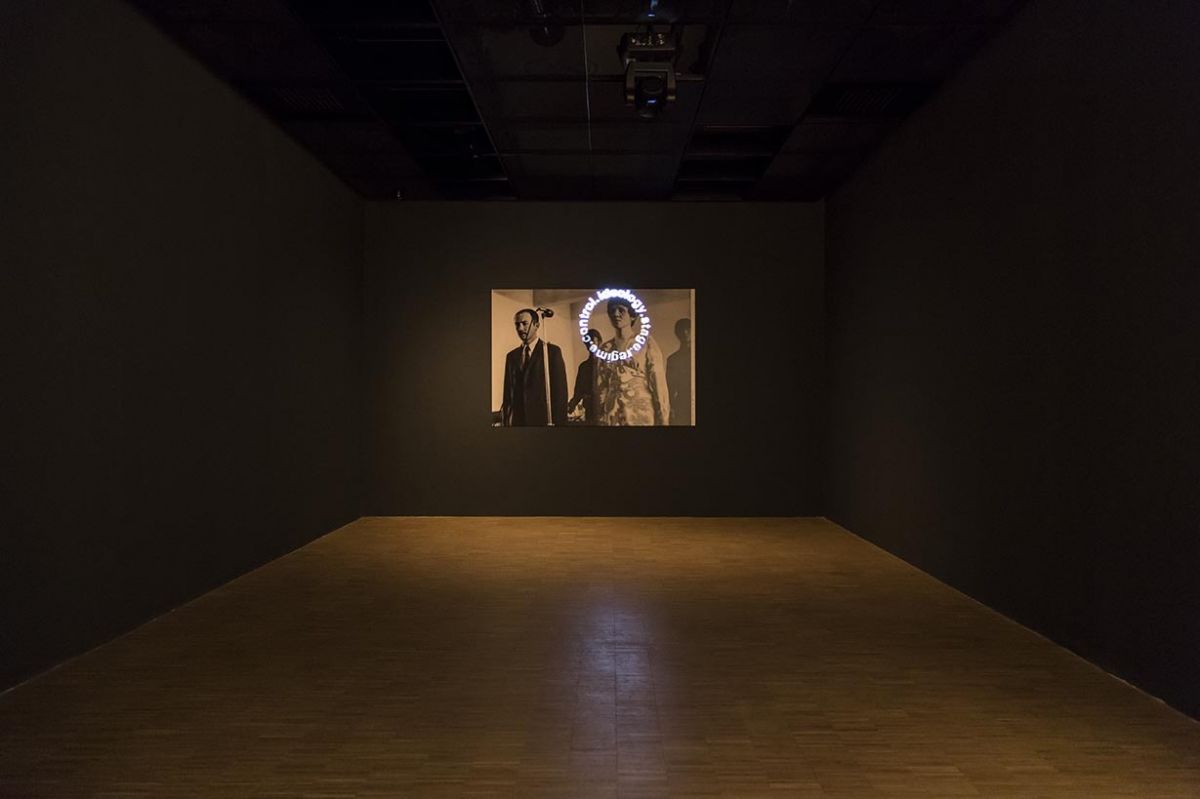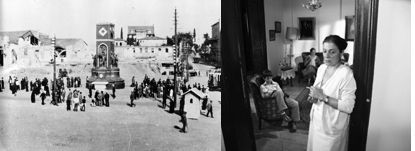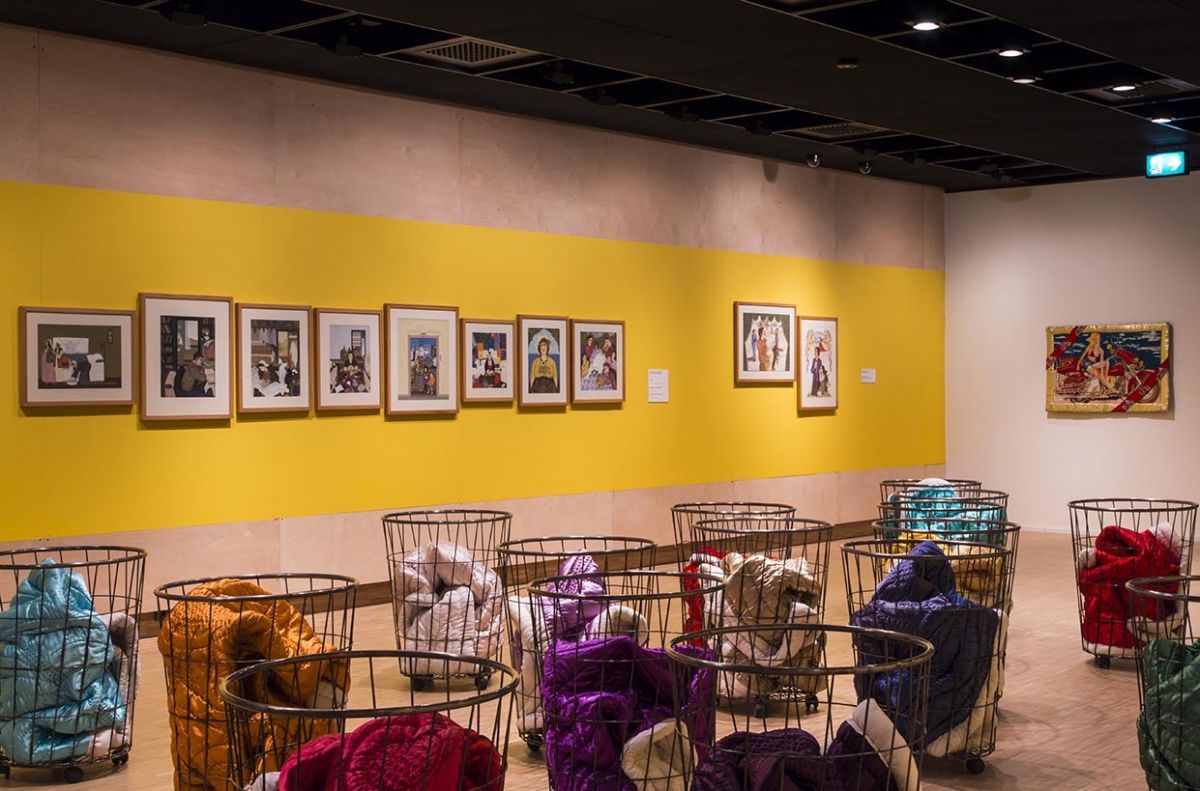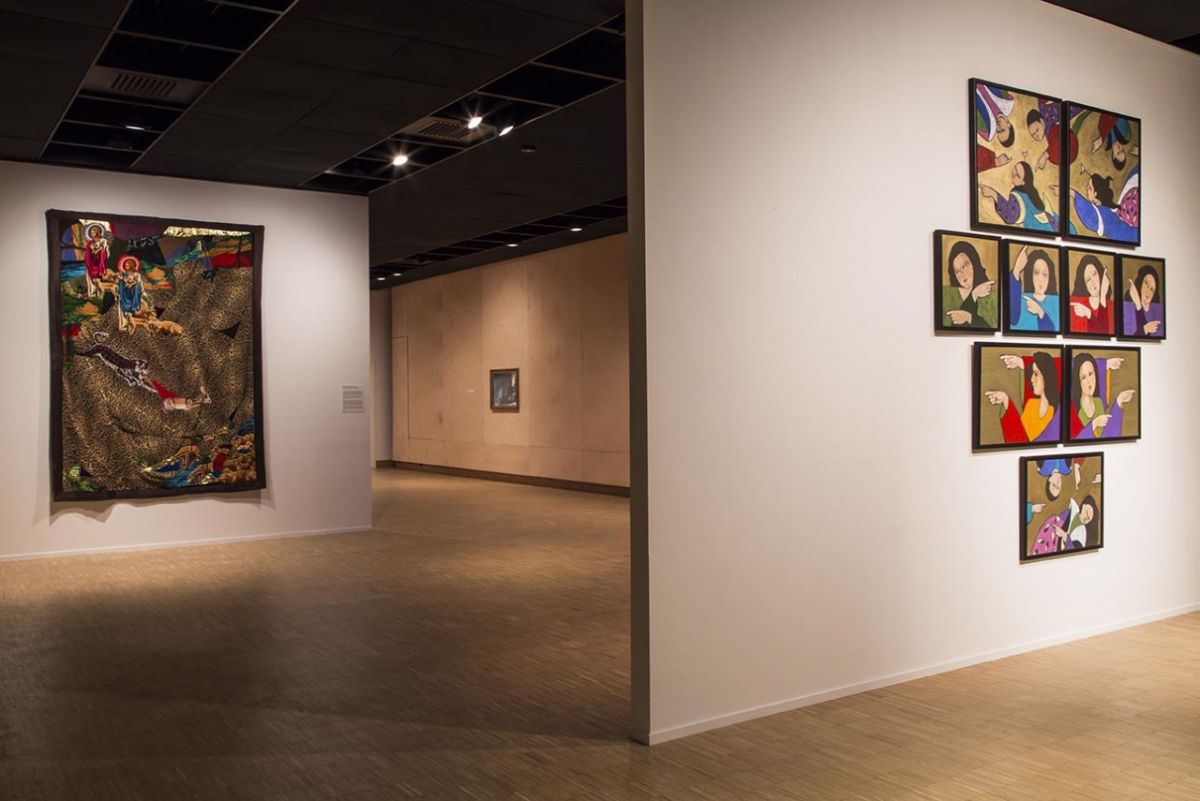The bold and poignant palette of Gülsün Karamustafa
NOVEMBER PAYNTER
September 17, 2013

Gülsün Karamustafa, Bühne, 1998, (SALT Beyoğlu, 2013)
Gülsün Karamustafa has been prolifically producing art since the 1970s, always painting and gradually introducing sculpture, installation and video to her practice. Her work reflects different aspects of her experience of living in Istanbul over the course of these years and it often offered a way to continue to move forward through political turmoil, urban transformation, problems with the military and a period spent trapped in Turkey after being denied a passport between 1971 and 1986. The necessity for Karamustafa to realise her works and have them presented relates each one to a specific moment in time. It also inserts them into a timeline of developing and changing perspectives on certain themes and concepts – such as, the female role in Turkish society, military control, cultural identity and migration – that Karamustafa intentionally returns to time and again, on each occasion reconsidering her response in the current contemporary context.
November Paynter: There are many recurring themes and subjects in your work from the 1980s up until the present day, do you feel that certain of these have gained in relevance or been lost along the way?
Gülsün Karamustafa: My mode of artistic production is to continually refer back to areas of interest and it is possible to select and group works from different dates, even different decades, that can be put under one heading or another. The paintings from the 80s still seem very contemporary today as they contain scenes and subjects that continue to exist. If you look around Istanbul, you still see issues of migration, clothes hanging across the streets, patterned fabrics and women in domestic settings. The political works that refer to military intervention such as Bühne [Stage], 1998, or the video installation Memory of a Square, 2005, viewed today still confront us with a feeling of the military’s continued presence and similar political considerations. It seems to be our fate that we continue to confront the same political agendas and conditions.

NP: Throughout this period of production did your newfound freedom to travel, after having being trapped in Turkey for so many years, change the approach of your practice?
GK: My attitude towards my artistic production was always to involve references and connotations from my lived environment and my internal thoughts, and so comes from myself, my true organism and my life in Istanbul. As I was unable to leave Turkey for 16 years because I was not permitted a passport, I become intent on observing everything that was going on around me. The opportunity to travel opened up another horizon that allowed international discourse on post-colonialism and paradigm shifts, but the subjects and interests I worked with continued to be those that were within my daily reach.
NP: You mentioned that your exhibition, Opening at Rodeo Gallery, is the first presentation of your work where you reveal yourself. Opening is intriguing as it is certainly not a retrospective, yet it manages to introduce works from all periods of your practice in a very balanced and inclusive way. How did you make the selection and how would you describe the intentions of this exhibition?
GK: I spent a long time in discussion with Sylvia Kouvali (Director of Rodeo) about how best to present a variety of works without the exhibition becoming weighed down by the question of whether it is, or should be, a retrospective or not. In the end we chose to describe the process and selection as a “sampling” of works. This approach allowed for a cleanly distributed selection of works with samples being included from the 80s up until 2007 with approximate five year lapses, so that there are works from 1980, 83, 85, 90, 94, 2000 and 2007. This process of sampling naturally involved a variety of media including textile collage, sculpture, painting, installation, prints and video.

NP: I want to ask you about strategies of colour, kitsch and the icon that you repeatedly use in your practice. In a conversation with Istanbul based artist Lukas Duwenhögger he brought up your exploitation of bold and bright colours and commented that comparatively the use of colour is quite lacking in the production of the younger generation of artists working in Istanbul today, particularly in painting where when colour is used it rarely involves pure pigments. Can you describe why the inclusion of colour comes so easily to your work?
GK: At school we were taught to work with less colour and we were told that we should only use colour that is created from a mixture of paint and never straight from the tube. Our tutor would say “It is only when you mix colours that they turn into paint”. But I wanted to shout and point out important issues and observations. It was probably the activist in me and the influence of Pop Art and a period spent producing magazine illustrations, posters and banners when young, in order to make money. Colour was, and still is a way to express my character and boldness and it seems that for the younger generation there is a fear of going too far with such a strong mode of self-expression.
NP: And what about your passion for kitsch?
GK: My obsession evolved from being inside Turkey during the 70s and 80s and seeing the flow of people from the rural to urban areas bringing kitsch with them. It was a confrontation of two ways of living and it was extremely interesting to see the interiors of these “new” homes. The aesthetics of hybridity, colour and strong imagery appeared everywhere. Then in the second half of the 80s I was able to travel and the influence of America began to be apparent across the globe. But, kitsch is dangerous. It is appealing and seductive and as an artist I have to apply kitsch and be careful not to fall into the trap of actually becoming kitsch. It is important to find a position that does not create a trap and to make sure that the work stands in a solid way, at a distance to its origin. This layer of appropriation is one that allows the viewer to stand in front of the kitsch and confront it, but with a barrier that does not make it immediately accessible. For example, in Panther on Stall, for which I created a stall with awkwardly angled legs to support the legs of the ceramic leopard statue, the object becomes something entirely different to what it was initially.

NP: And finally, can you comment on the common references to iconic figures and the notion of what an icon is in itself.
GK: This is totally related to Istanbul, an Orthodox city full of iconography. I have painted icons and they also appear in other works such as the quilts with Jesus or Elvis, a work with Greta Garbo, the sculpture of the leopard etc. I like to express myself through the icon, the symmetry of the icon and the symbolism of the altar. It is a personal and instinctual relationship. For example, I waited until a photograph of myself standing in front of the military court had become iconic before I made the work Bühne in which it appears, because I understood that at that moment the image and its references were mature and therefore ready to be shared and reconsidered with a larger audience.
- - -
This interview was conducted at the time of Gülsün Karamustafa’s exhibition Opening at Rodeo, Istanbul, 29 April – 23 May 2009 for IDEA magazine, issue no.32, 2009.
November Paynter: There are many recurring themes and subjects in your work from the 1980s up until the present day, do you feel that certain of these have gained in relevance or been lost along the way?
Gülsün Karamustafa: My mode of artistic production is to continually refer back to areas of interest and it is possible to select and group works from different dates, even different decades, that can be put under one heading or another. The paintings from the 80s still seem very contemporary today as they contain scenes and subjects that continue to exist. If you look around Istanbul, you still see issues of migration, clothes hanging across the streets, patterned fabrics and women in domestic settings. The political works that refer to military intervention such as Bühne [Stage], 1998, or the video installation Memory of a Square, 2005, viewed today still confront us with a feeling of the military’s continued presence and similar political considerations. It seems to be our fate that we continue to confront the same political agendas and conditions.

Gülsün Karamustafa, Memory of a Square, 2005
NP: Throughout this period of production did your newfound freedom to travel, after having being trapped in Turkey for so many years, change the approach of your practice?
GK: My attitude towards my artistic production was always to involve references and connotations from my lived environment and my internal thoughts, and so comes from myself, my true organism and my life in Istanbul. As I was unable to leave Turkey for 16 years because I was not permitted a passport, I become intent on observing everything that was going on around me. The opportunity to travel opened up another horizon that allowed international discourse on post-colonialism and paradigm shifts, but the subjects and interests I worked with continued to be those that were within my daily reach.
NP: You mentioned that your exhibition, Opening at Rodeo Gallery, is the first presentation of your work where you reveal yourself. Opening is intriguing as it is certainly not a retrospective, yet it manages to introduce works from all periods of your practice in a very balanced and inclusive way. How did you make the selection and how would you describe the intentions of this exhibition?
GK: I spent a long time in discussion with Sylvia Kouvali (Director of Rodeo) about how best to present a variety of works without the exhibition becoming weighed down by the question of whether it is, or should be, a retrospective or not. In the end we chose to describe the process and selection as a “sampling” of works. This approach allowed for a cleanly distributed selection of works with samples being included from the 80s up until 2007 with approximate five year lapses, so that there are works from 1980, 83, 85, 90, 94, 2000 and 2007. This process of sampling naturally involved a variety of media including textile collage, sculpture, painting, installation, prints and video.

Installation view, SALT Beyoğlu, 2013
NP: I want to ask you about strategies of colour, kitsch and the icon that you repeatedly use in your practice. In a conversation with Istanbul based artist Lukas Duwenhögger he brought up your exploitation of bold and bright colours and commented that comparatively the use of colour is quite lacking in the production of the younger generation of artists working in Istanbul today, particularly in painting where when colour is used it rarely involves pure pigments. Can you describe why the inclusion of colour comes so easily to your work?
GK: At school we were taught to work with less colour and we were told that we should only use colour that is created from a mixture of paint and never straight from the tube. Our tutor would say “It is only when you mix colours that they turn into paint”. But I wanted to shout and point out important issues and observations. It was probably the activist in me and the influence of Pop Art and a period spent producing magazine illustrations, posters and banners when young, in order to make money. Colour was, and still is a way to express my character and boldness and it seems that for the younger generation there is a fear of going too far with such a strong mode of self-expression.
NP: And what about your passion for kitsch?
GK: My obsession evolved from being inside Turkey during the 70s and 80s and seeing the flow of people from the rural to urban areas bringing kitsch with them. It was a confrontation of two ways of living and it was extremely interesting to see the interiors of these “new” homes. The aesthetics of hybridity, colour and strong imagery appeared everywhere. Then in the second half of the 80s I was able to travel and the influence of America began to be apparent across the globe. But, kitsch is dangerous. It is appealing and seductive and as an artist I have to apply kitsch and be careful not to fall into the trap of actually becoming kitsch. It is important to find a position that does not create a trap and to make sure that the work stands in a solid way, at a distance to its origin. This layer of appropriation is one that allows the viewer to stand in front of the kitsch and confront it, but with a barrier that does not make it immediately accessible. For example, in Panther on Stall, for which I created a stall with awkwardly angled legs to support the legs of the ceramic leopard statue, the object becomes something entirely different to what it was initially.

Installation view, SALT Beyoğlu, 2013
NP: And finally, can you comment on the common references to iconic figures and the notion of what an icon is in itself.
GK: This is totally related to Istanbul, an Orthodox city full of iconography. I have painted icons and they also appear in other works such as the quilts with Jesus or Elvis, a work with Greta Garbo, the sculpture of the leopard etc. I like to express myself through the icon, the symmetry of the icon and the symbolism of the altar. It is a personal and instinctual relationship. For example, I waited until a photograph of myself standing in front of the military court had become iconic before I made the work Bühne in which it appears, because I understood that at that moment the image and its references were mature and therefore ready to be shared and reconsidered with a larger audience.
This interview was conducted at the time of Gülsün Karamustafa’s exhibition Opening at Rodeo, Istanbul, 29 April – 23 May 2009 for IDEA magazine, issue no.32, 2009.

